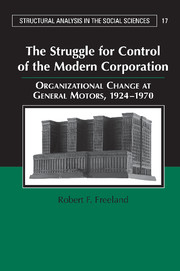 The Struggle for Control of the Modern Corporation
The Struggle for Control of the Modern Corporation Book contents
- Frontmatter
- Contents
- List of Figures and Tables
- Acknowledgments
- 1 The Modern Corporation and the Problem of Order
- 2 Creating Corporate Order: Conflicting Versions of Decentralization at GM, 1921–1933
- 3 Administrative Centralization of the M-form, 1934–1941
- 4 Participative Decentralization Redefined: Mobilizing for War Production, 1941–1945
- 5 The Split between Finance and Operations: Postwar Problems and Organization Structure, 1945–1948
- 6 Consent as an Organizational Weapon: Coalition Politics and the Destruction of Cooperation, 1948–1958
- 7 Consent Destroyed: The Decline and Fall of General Motors, 1958–1980
- 8 Conclusion
- Appendix: General Motors' Financial Performance, 1921–1987
- References
- Index
2 - Creating Corporate Order: Conflicting Versions of Decentralization at GM, 1921–1933
Published online by Cambridge University Press: 05 August 2011
- Frontmatter
- Contents
- List of Figures and Tables
- Acknowledgments
- 1 The Modern Corporation and the Problem of Order
- 2 Creating Corporate Order: Conflicting Versions of Decentralization at GM, 1921–1933
- 3 Administrative Centralization of the M-form, 1934–1941
- 4 Participative Decentralization Redefined: Mobilizing for War Production, 1941–1945
- 5 The Split between Finance and Operations: Postwar Problems and Organization Structure, 1945–1948
- 6 Consent as an Organizational Weapon: Coalition Politics and the Destruction of Cooperation, 1948–1958
- 7 Consent Destroyed: The Decline and Fall of General Motors, 1958–1980
- 8 Conclusion
- Appendix: General Motors' Financial Performance, 1921–1987
- References
- Index
Summary
Analyses of General Motors' organizational history have focused primarily on the period from 1921 to 1925, when the corporation created and perfected the M-form. The basic contours of this structure are well known, having been described extensively both by the men who built it and by analysts of the modern corporation. Yet the textbook M-form outlined in those writings existed only briefly at GM; it quickly gave way to “corrupted” versions of decentralization that involved division managers in strategic planning. Because existing analyses have not examined the changes made in GM's organization over time, they have missed or misinterpreted these developments. In this chapter, I show that top executives sought to introduce participative decentralization as a means of creating divisional consent to organizational policies. Yet owners opposed such divisional participation in planning, and their control of scarce investment funds and key committees during the 1920s enabled them to block management's efforts to modify GM's formal structure. General office executives responded by attempting to create participative decentralization through informal practices, touching off a debate over organizational form that would last for decades.
The chapter begins with an overview of the historical conditions that led to decentralization. GM's M-form arose in response to the three-way problem of order created by the ongoing division of labor among owners, general executives, and division managers. Within this context, two different images of decentralization emerged. Focusing on the separation between owners and managers, owners sought to reestablish shareholder control over a corporation in crisis.
- Type
- Chapter
- Information
- The Struggle for Control of the Modern CorporationOrganizational Change at General Motors, 1924–1970, pp. 43 - 80Publisher: Cambridge University PressPrint publication year: 2000
